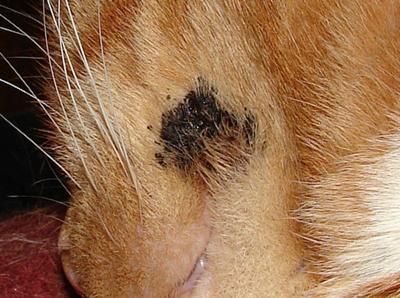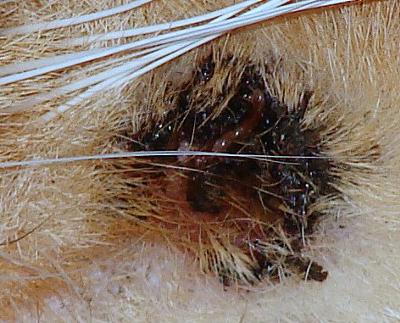Cat Skin Infection on Behind
My female cat was attacked by street dogs several months ago and has since had partial paralysis of her hind limbs, i.e. one of the legs seems to have semi-recovered (although she is not able to stand on it) while the other is pretty much useless.
I took her to a local vet, but after examining x-rays and prescribing some antibiotics, she said there is nothing else she could do, because the spine injury was too severe.
My cat, Maddy, has since been dragging her lower body around in the house. She is in fact rather active, and thus wanders a lot. All floors in the house are either smooth ceramic tiles or smooth hardwood parquet. But because she is also incontinent as a result of her injury, she constantly drags her behind through her own filth.
I have tried to frequently bathe her and even tried diapers to keep her skin and fur as dry and clean as possible. But now Maddy has developed a serious skin infection.
She has lost most of the fur on her behind and on one of the legs and the infection seems to be getting worse. It manifests itself as rather ulcerous-looking with lots of slimy mucous covering the affected areas.
Have tried an oral broad spectrum antibiotic (Ampicillin, Bactrim) in conjunction with antibacterial and antifungal creams (including Fucicort) applied to the infected areas. I frequently clean the area with a hydrogen peroxide solution be and - after drying her up - apply the cream. The problem is that the cream is
Have tried diapers and even a regular dressing with gauze and bandages to keep the cream on longer. To no avail, because she rips those off within an hour. I'm at the end of my wits.
Another trip to the vet is out of the question at the moment due to my busy work schedule (I work from home, so looking after the cat is no problem, but taking her on a long trip to reach the next vet is). I live in Thailand and vets are scattered far and between. Any advice would be appreciated.
Editor Suggestion
Hello,
The first thing that comes to mind is to make sure that none of the ointments that you are using on your cat’s skin contain a corticosteroid (e.g., cortisone, hydrocortisone, etc.). These could actually make the infection worse rather than better.
Use an antiseptic like povidone-iodine or chlorhexiderm to clean the area and then once the skin is dry apply a protectant like a diaper cream containing zinc-oxide such as Destin. Continue with the oral, broad spectrum antibiotics.
That said, I am afraid that unless you can come up with a way of keeping your cat’s skin from rubbing on the floor as she moves about, you are probably fighting a losing battle.
Have you thought about purchasing or making a kitty wheelchair? (see Eddie's Wheels) These can really work as long as you make sure that the wheelchair itself doesn’t create pressure sores.
Good luck
Jennifer Coates, DVM
Comments for Cat Skin Infection on Behind
|
||
|
||
|
Click here to add your own comments Join in and write your own page! It's easy to do. How? Simply click here to return to Cat Skin. |
Persistant Cat Skin Infection
by Edward Frankman
(Tigard, Oregon)

Persistant cat skin infection
This is a formally feral cat that I have taken in. I am the only person he is not afraid of. Is about 10 years old. The infection looks like there is a rust colored worm on it.
Thanks,
Edward Frankman
Editor Comment
Hi Edward,
There are some parasitic worms that can infect the skin of cats. The only one that I’ve seen personally is the larvae of a bot fly, which this doesn’t appear to be.
It would be best to get your cat in to see a veterinarian. If he becomes extremely nervous around other people, the vet could always give him a sedative. A local veterinarian would also be in the best position to know what types of parasites are most common to the area in which you and your cat live and what danger they pose to your cat’s health.
If you have not already done so, your cat should also be tested for feline leukemia virus, feline immunodeficiency virus, and intestinal parasites; brought up to date on vaccines and parasite control; and be neutered.
Regards,
Jennifer Coates, DVM
Comments for Persistant Cat Skin Infection
|
||
|
||
|
Click here to add your own comments Join in and write your own page! It's easy to do. How? Simply click here to return to Cat Skin. |



